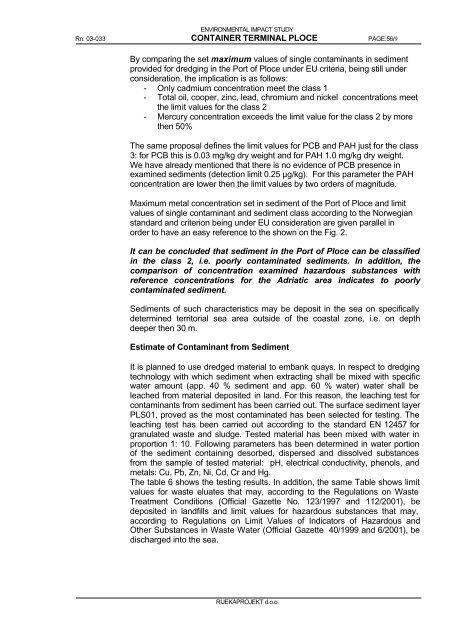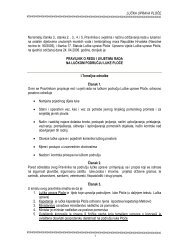HEADING PAGE - port of ploce authority * welcome
HEADING PAGE - port of ploce authority * welcome
HEADING PAGE - port of ploce authority * welcome
You also want an ePaper? Increase the reach of your titles
YUMPU automatically turns print PDFs into web optimized ePapers that Google loves.
ENVIRONMENTAL IMPACT STUDY<br />
Rn: 03-033 CONTAINER TERMINAL PLOCE <strong>PAGE</strong>:56/9<br />
By comparing the set maximum values <strong>of</strong> single contaminants in sediment<br />
provided for dredging in the Port <strong>of</strong> Ploce under EU criteria, being still under<br />
consideration, the implication is as follows:<br />
- Only cadmium concentration meet the class 1<br />
- Total oil, cooper, zinc, lead, chromium and nickel concentrations meet<br />
the limit values for the class 2<br />
- Mercury concentration exceeds the limit value for the class 2 by more<br />
then 50%<br />
The same proposal defines the limit values for PCB and PAH just for the class<br />
3: for PCB this is 0.03 mg/kg dry weight and for PAH 1.0 mg/kg dry weight.<br />
We have already mentioned that there is no evidence <strong>of</strong> PCB presence in<br />
examined sediments (detection limit 0.25 µg/kg). For this parameter the PAH<br />
concentration are lower then the limit values by two orders <strong>of</strong> magnitude.<br />
Maximum metal concentration set in sediment <strong>of</strong> the Port <strong>of</strong> Ploce and limit<br />
values <strong>of</strong> single contaminant and sediment class according to the Norwegian<br />
standard and criterion being under EU consideration are given parallel in<br />
order to have an easy reference to the shown on the Fig. 2.<br />
It can be concluded that sediment in the Port <strong>of</strong> Ploce can be classified<br />
in the class 2, i.e. poorly contaminated sediments. In addition, the<br />
comparison <strong>of</strong> concentration examined hazardous substances with<br />
reference concentrations for the Adriatic area indicates to poorly<br />
contaminated sediment.<br />
Sediments <strong>of</strong> such characteristics may be deposit in the sea on specifically<br />
determined territorial sea area outside <strong>of</strong> the coastal zone, i.e. on depth<br />
deeper then 30 m.<br />
Estimate <strong>of</strong> Contaminant from Sediment<br />
It is planned to use dredged material to embank quays. In respect to dredging<br />
technology with which sediment when extracting shall be mixed with specific<br />
water amount (app. 40 % sediment and app. 60 % water) water shall be<br />
leached from material deposited in land. For this reason, the leaching test for<br />
contaminants from sediment has been carried out. The surface sediment layer<br />
PLS01, proved as the most contaminated has been selected for testing. The<br />
leaching test has been carried out according to the standard EN 12457 for<br />
granulated waste and sludge. Tested material has been mixed with water in<br />
pro<strong>port</strong>ion 1: 10. Following parameters has been determined in water <strong>port</strong>ion<br />
<strong>of</strong> the sediment containing desorbed, dispersed and dissolved substances<br />
from the sample <strong>of</strong> tested material: pH, electrical conductivity, phenols, and<br />
metals: Cu, Pb, Zn, Ni, Cd, Cr and Hg.<br />
The table 6 shows the testing results. In addition, the same Table shows limit<br />
values for waste eluates that may, according to the Regulations on Waste<br />
Treatment Conditions (Official Gazette No. 123/1997 and 112/2001), be<br />
deposited in landfills and limit values for hazardous substances that may,<br />
according to Regulations on Limit Values <strong>of</strong> Indicators <strong>of</strong> Hazardous and<br />
Other Substances in Waste Water (Official Gazette 40/1999 and 6/2001), be<br />
discharged into the sea.<br />
RIJEKAPROJEKT d.o.o.



